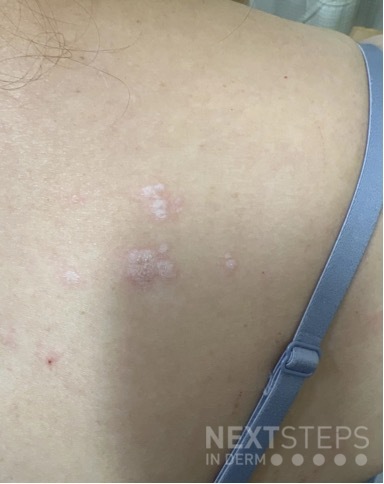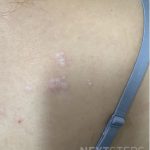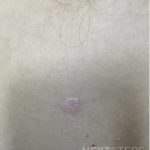February 2023 Case Study
by Alexis E. Carrington, MD
A 52 year old female with a past medical history of vulvar lichen sclerosus presents to the clinic for a rash on the back and legs for 8 months. She reports the rash is itchy and the areas on the back are worse during the summer months and with sweating. She is using Aquaphor ointment and a topical antibiotic cream with no improvement. She denies any family history of similar findings or exposure to new personal or household items. Punch biopsy of a lesion on the back is consistent with lichen sclerosus.
Which of the following is true about lichen sclerosus?
A.) It is associated with HLA-DQ2
B.) It is associated with anti-extracellular matrix protein 1 antibodies
C.) Genital lesions can be associated with development of BCC
D.) Treatment of extragenital disease involves the use of a low-potency topical steroid
- Image 1
- Image 2
Extragenital lichen sclerosus typically favors the neck, shoulders, trunk, proximal extremities, flexor wrists and sites of trauma. It is associated with xerosis and mild pruritus, but is usually asymptomatic. The lesions start as white, shiny, polygonal papules that coalesce into plaques and evolve into atrophic patches and plaques. Lesions may also affect the skin around the eye and other areas of the face.
Lichen sclerosus is usually a clinical diagnosis but a biopsy is reasonable to confirm diagnosis. Topical steroids are the gold standard for this condition. Patients should be referred to a dermatologist and gynecologist or urologist for management of genitourinary complications.
Correct answer: B.) It is associated with anti-extracellular matrix protein 1 antibodies
Answer A is associated with Dermatitis Herpetiformis, whereas lichen sclerosus is associated with HLA-DQ7. There is an increased risk of genital squamous cell carcinoma in both men and women with lichen sclerosus, not basal cell carcinoma (Answer C). Treatment of extragenital disease involves the use of high potency topical steroids, rather than low-potency (Answer D).
References
- Bolognia, Jean Dermatology volume 2. Mosby, 2018.
- Fistarol SK, Itin Diagnosis and treatment of lichen sclerosus: an update. Am J Clin Dermatol. 2013 Feb;14(1):27-47. PubMed ID: 23329078
- Lewis FM, Tatnall FM, Velangi SS, et al. British Association of Dermatologists guidelines for the management of lichen sclerosus, Br J Dermatol. 2018 Apr;178(4):839-853. PubMed ID: 29313888




